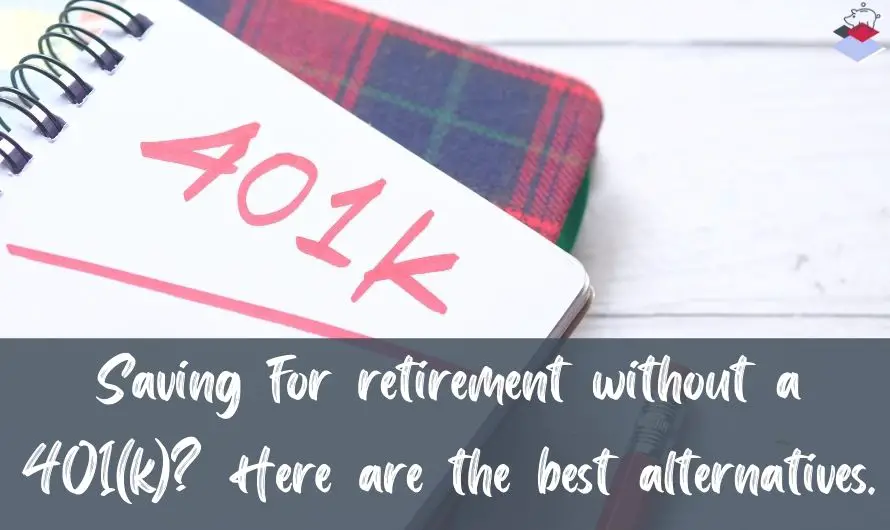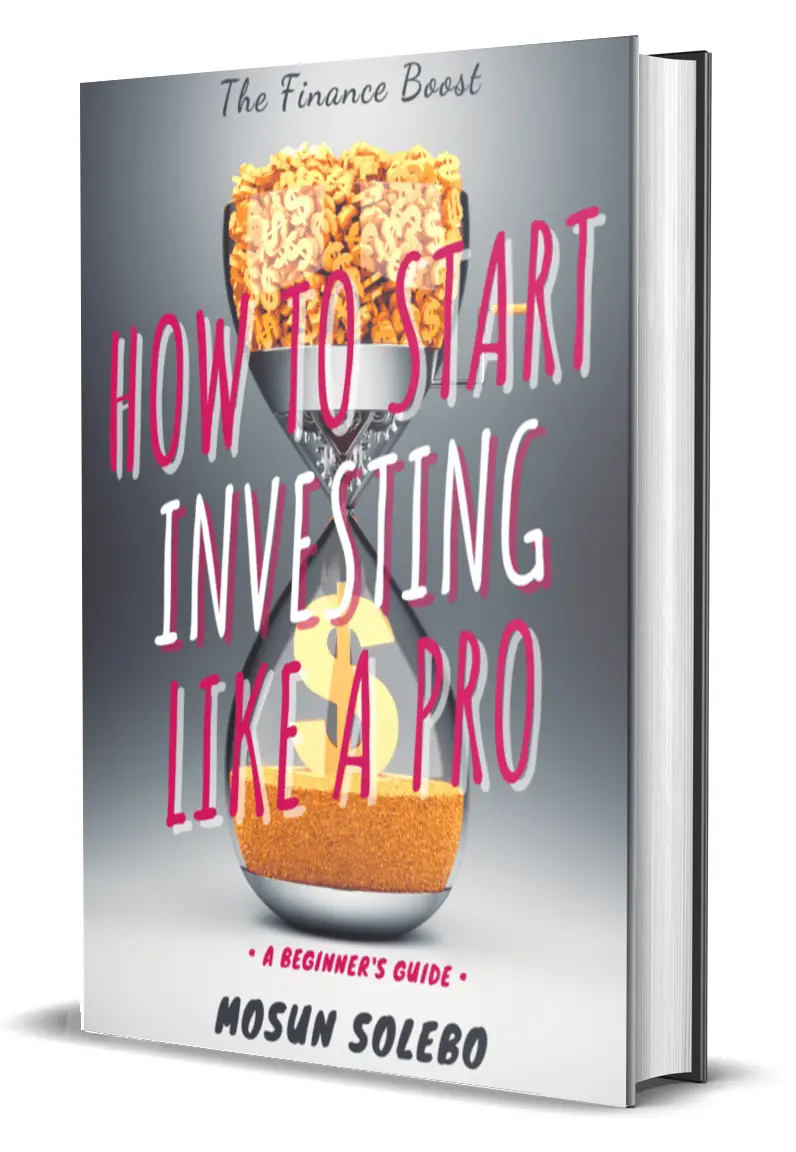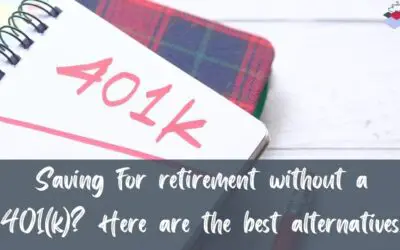How to open a 401k without an employer? If you want to know how and what other options are available out there, keep reading.
The 401(k) is one of the most common retirement accounts. Moreover, it is one way most Americans save for retirement. Yet, while it’s fairly accessible, many still struggle to have one.
Nearly one-third of American workers don’t have an employer-sponsored retirement savings account. And while some employees do have access to it, not all employers are willing to match what their employees put into it.
However, if you find yourself working without 401(k) retirement benefits, there’s still hope.
Yes, you can still save for retirement and reach your financial goals. Here’s how.
Related: How to open a Roth IRA Account? Simple and Easy Beginner’s Guide.
How to open a 401k without an employer
1. Talk to your employer.

The first way is a bold move, but for some, it may work. If you can, try to talk and negotiate with your employer about opening an employer-sponsored retirement savings account.
You can reason out to your boss and justify why having a 401(k) will increase the morale in your company and what other advantages it will bring to the table.
Why your employer doesn’t offer a 401k

One of the reasons an employer might not include a 401(k) plan is the underlying costs. Another is maybe the job offered is entry-level or part-time, so you can’t expect to have a retirement account package there.
The average worker in such jobs may be very young or trying to make ends meet. Hence retirement is the last thing they have in mind.
Aside from that, some companies may see that only a few of their employees participate in the 401(k) program, so they decided to end it because it makes no sense to keep it. Or, the company is losing money so one way to salvage the firm is to reduce expenses.
Other reasons may include new management coming in and not knowing how to proceed with one or looking for alternatives.
Lastly, most small businesses or start-ups usually don’t offer 401k because of the cost, or probably they don’t know how to set up and administer it since they’re in the initial stages of business growth. Hence, they can’t afford it.
However, some had managed to match it with decent health or dental benefits.
So, it’s also a matter of weighing your options. If you think your pay is great and receive other valuable benefits, then maybe handling retirement accounts and investing it on your own is much better.
Moreover, always think about what else you are getting and your other viable alternatives.
How to open a 401k without an employer– 6 Best Alternatives
To jumpstart your retirement savings, here are other options you can try even without a 401k plan.
2. IRA (Individual Retirement Account)
With no access to 401k, this is your next best course of action. There are two main types: The Roth IRA and Traditional IRA.
Roth IRA
In Roth IRA, always remember that your contribution will be made using after-tax dollars. It means that you will be paying your taxes upfront during your working years. So when you withdraw, it will be tax-free.
The Roth IRA is regulated by IRS (Internal Revenue Service), and it follows a contribution limit. The amount of Roth IRA contributions you can make for 2021-2022 is $6,000 ($7,000 for those 50 years or older).
Moreover, in Roth IRA, income limits apply.
To be eligible in Roth IRA, you must have an earned income and a MAGI (Modified Adjusted Gross Income). The MAGI is your total gross income less the taxes or any deductions you claim.
It has to be < $198,000 for married couples filing jointly or $125,000 for a single individual.
PRO TIP: For married couples out there, you can make use of a spousal IRA. Even if only one of you is working and has an earned income, a working spouse can contribute on behalf of a spouse who earns little to no income at all.
Related: Index Funds for Roth IRA- 3 Easy Ways to Start Index Investing.
Traditional IRA
Almost similar to the Roth IRA is the Traditional IRA. The max contribution per year is also $6,000 ($7,000) if older than 50.
In Traditional IRA, contributions are pre-tax. It means you don’t pay while you contribute during your working years, but you pay tax when you withdraw.
Furthermore, there is an early withdrawal penalty if you withdraw before 59 ½. The IRS also regulates the Traditional IRA regarding how much you can contribute plus income limits.
Retirement Accounts for the Self-employed, Freelancers, and Independent Contractors

3. SEP-IRA (Simplified Employee Pension plan)
How to open a 401k without an employer, you may ask?
If you’re an entrepreneur or small business owner (who also wants to help their employees in their retirement savings), you can use the SEP-IRA options. Freelancers and self-employed individuals can also fit in this account.
Like the Traditional IRA, contributions are pre-tax, but you pay taxes once you withdraw.
What sets the SEP-IRA apart from other retirement accounts is that only the employer can contribute to an employee’s SEP-IRA. The SEP-IRA is for those business owners managing their retirement savings and who don’t mind contributing the same amount to every employee.
So if you commit up to 15% of your income to your retirement savings, you must match that same amount to every employee.
Aside from that, the IRS sets contribution limits for SEP-IRA. It is up to 25% of the employee’s compensation or $58,000 for 2021 ($61,000 for 2022)
4. Solo 401(k)
The self-employed 401(k), also known as the Solo 401(k), works the same way as an employer-sponsored 401(k).
But the good thing about it is that you can both act as the employer and the employee. This gives you flexibility and control in terms of handling your retirement savings.
So, how does it work?
As an employee, you can choose to contribute pre-tax dollars into a Traditional Solo 401(k) or after-tax dollars into a Roth Solo 401(k).
UPDATE: IRS announced income limit increase. You can now contribute up to $20,500 in 2022 (or $27,000 if you’re age 50 or older).
On the other hand, you can contribute up to 25% of your eligible earnings as an employer.
NOTE: Consult a tax expert or check the IRS website for more in-depth details and guidelines.
5. Simple IRA
How to open a 401k without an employer? If you run a business with 100 employees or less, Simple IRA is another next bet for self-employed like you.
Like a Traditional 401k plan that a large employer would provide, Simple IRA works the same. Employees can set a percentage of pre-tax dollars to contribute, and employers can match those contributions.
As an employer, Simple IRA requires you to offer up to a 3% match for your employee’s salary yearly—and contributions are tax-deductible. Aside from that, SIMPLE IRAs come with an individual limit of $13,500 this 2021 and $14,000 in 2022.
Additionally, there are also what are typically called the nonelective contributions. According to the IRS official website, it states that: Instead of matching contributions, an employer can choose to make nonelective contributions of 2% of each eligible employee’s compensation. If the employer makes this choice, it must make nonelective contributions whether or not the employee chooses to make salary reduction contributions.
6. HSA (Health Savings Account)
Lastly, another excellent alternative to consider is the health savings account or HSA.
An HSA offers several benefits, most especially in the tax arrears. This includes ax deduction, tax-free withdrawals to pay for qualified medical expenses, and more.
HSA makes sense if you want to tap into your money anytime whenever medical emergencies come up. Unlike in 401(k), you can also use it to pay for your medical bills, but tax terms apply.
However, illnesses and diseases are unpredictable. It’s also difficult to set aside exact amounts or budgets for health care expenses. Hence, an HSA will make more sense if you have a plan that doesn’t cover health and medical expenses.
Essentially, HSA can help you pay for your health expenses quickly, making them affordable, can lower your taxes, and can let you save for retirement.
Related: 5 Reasons Why Investing in Index Funds for Retirement is Worth It.
Can I open a 401k on my own?
Typically, a 401(k) is an employer-sponsored retirement account. You must have a job or an earned income to be eligible for it.
So if you want to open a 401(k) on your own, opt for the Solo 401(k). It is ideal for self-employed or freelancers. Generally, a Solo 401(k) contributions are higher since you are both the employer and employee.
How do I start a 401k if my employer doesn’t offer it?
Don’t be discouraged; you can still access other retirement accounts even without a 401(k).
Below are the summarized alternatives to 401(k)
| Retirement Option | Ideal for | Yearly Max Contribution (under 50 years old) |
| Roth IRA | Any earned income | $6,000 |
| Traditional IRA | Any earned income | $6,000 |
| Solo 401(k) | Self-employed | $20,500 (and anything up to 25% of income) |
| Simple IRA | Small Business Owners | $13,500 for 2021, $14,000 for 2022 |
| SEP-IRA | Freelancers, Self-employed | 25% of earned income (up to $61,000) |
How do I set up a 401k for myself?

A Solo 401(k) is easy to administer, set up, and maintain. As a result, it’s an excellent option for small business owners with no other full-time employees or those self-employed individuals. Moreover, it offers higher contribution limits than most traditional IRAs.
How to open a 401k without an employer:
- Understand your eligibility requirements.
- Find a Solo 401(k) provider.
- Complete your documents.
- Open your Solo 401(k) account.
- Make contributions.
If you find yourself hiring other or more employees in the future, you can easily convert the Solo 401(k) to accommodate your likings, such as actual 401k or other retirement accounts.
How to open a 401k without an employer- Final thoughts
Not every employer offers a 401(k) plan. So, if you’ve got one of those today, lucky you! But, don’t leave free money on the table.
You must consistently contribute to your retirement account because your employer matches it. Besides, your retirement income is YOUR responsibility.
We hope that this article helps you in some way on how to open a 401k without an employer.
It’s also smart to roll over your 401(k) plan to an IRA (or any other retirement accounts), cash it out, keep the plan as is, or you can consolidate it to a new 401(k) if you are with a new employer. Figure out a way to find your old hidden 401(k); you never know!
Above all, your retirement is your ultimate responsibility. So start planning for retirement early, no matter how sooner or later you want to retire.
Hence, your ability to retire comfortably in the future is in your hands today.
Are you planning for retirement yet, or are you winging it?










0 Comments